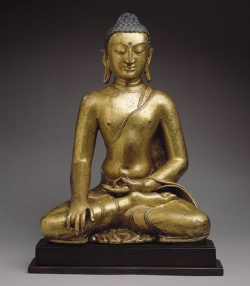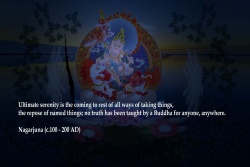Domesticating the Dharma: Buddhist Cults and the Hwaom Synthesis in Silla Korea.
Richard D. McBride, II. Domesticating the Dharma: Buddhist Cults and the Hwaom Synthesis in Silla Korea. Honolulu: University of Hawaii Press, 2008. xiii + 228 pp. $52.00 (cloth), ISBN 978-0-8248-3087-8.
Reviewed by Sem Vermeersch (Kyujanggak Institute for Korean Studies)
Published on H-Buddhism (July, 2008)
The Practice of Buddhism in the Silla Dynasty The oft-repeated mantra that Korean Buddhism has been neglected by mainstream Buddhist studies is becoming less true. This book fills another major gap in our knowledge of Korean Buddhism by offering a framework for understanding how Buddhism was practiced "on the ground" in the Silla period, from its introduction ca. 527-535 to the end of Unified Silla in 935. Most previous research on Silla Buddhism has focused either on the introduction of the tradition from China or on selected scholastic works; McBride instead considers what people actually practiced, relying mainly on written traces of devotional acts or guiding beliefs, and argues that these were shared by elites and commoners alike.
The main focus is on what the author terms "cults," devotional practices centered on either a Buddha or a bodhisattva, and the book is organized roughly according to the development of the main cults. The first chapter sketches the historical background to the development of Buddhism in early Silla, from the martyrdom of Ich'adon in 527/528 to the separation of worldly and religious power under King Munmu (r. 661-681). Chapter 2 traces the development of the Maitreya cult in northeast Asia and its appropriation by Silla from the late sixth century onwards. Although Maitreya never really left the scene, only in pre-unification Silla was he truly dominant. In chapter 3 the inexorable rise of Avalokite?vara as the bodhisattva-savior par excellence takes center stage. By the end of the eighth century, however, the author argues, these cults were integrated into a grand synthesis spurred by the Hwa?m tradition (Avata?saka, Ch. Huayan). Consequently the last two chapters are devoted to this Hwa?m synthesis. Chapter 4 tracks the rise of Hwa?m Buddhism, and chapter 5 explores some of the main venues where this synthesis was put into practice.
There are no substantial narrative sources that can be dated to the period discussed. The only chronicle for Buddhist life in the Three Kingdoms and Unified Silla periods remains Iry?n's (1206-89) Samguk yusa (Memorabilia of the Three Kingdoms), compiled in the late thirteenth century. Despite its distance from the events related, the author shows that with a close text-critical reading of the work, combined with cross-checking of other sources, it can be a reliable source for the study of Silla Buddhist practices. As the Samguk yusa has become enshrined as an icon of Korean culture, it has become difficult to see beyond the strange "otherness" of its semi-magical stories. But by looking at the larger context of Buddhist devotional practices and stories, and remaining inscriptions and images, McBride has succeeded in restoring its Buddhist credentials and has gone a long way towards explaining how many stories reflect the Korean appropriation of Buddhist devotional and salvific trends.
The author puts forward many challenging and thought-provoking new interpretations and theses, but two in particular appear to be central. The first is that these Buddhist devotional practices should not be seen merely as "popular cults," but as essential practices with which elite monks such as ?isang (625-702) identified. The second is that by the eighth century the Avata?saka s?tra (K. Hwa?m ky?ng, Ch. Huayan jing) provided the framework for integrating all the disparate cults into a coherent whole.
In the case of the former thesis, the author follows the lead of Gregory Schopen's research on Indian Buddhism and Peter Brown's on medieval Christianity to show that previous scholarship has tended to "rationalize" great religious exegetes by separating the intellectual from the devotional. However, worship of bodhisattvas such as Avalokite?vara or Mañju?r? was probably as important to doctrinal specialists as to ordinary believers; indeed, it was elite monks like W?nhyo (617-686) and ?isang who introduced the practices in the first place. While I would not go as far as the author in collapsing distinctions between popular and elite practices, I wholly agree that we cannot understand the true impact of Buddhism if we separate the practice-oriented from the exegetical tradition.
The overarching importance of the Avata?saka s?tra for Unified Silla has been noted by previous scholars, but McBride goes one step further in proposing that it "was the only intellectual tradition to incorporate cultic practices successfully" (p. 109). References to the Avata?saka s?tra, the Hwa?m school, and practices related to the Hwa?m tradition abound in the sources, but until now this has simply been taken as evidence of the school's importance. However, the author argues that it did not simply push other Buddhist schools or cults aside, but provided a framework to integrate them. He is especially successful in revealing how it constructed spatial dominance. Through the construction of temples or the transformation of mountains into holy mountains imbued with Hwa?m cosmology, the school's imagery or symbols were virtually superimposed on the Korean landscape. Besides the well-known connection of Odae-san (Five-Terrace Mountain, created in the image of Wutai shan in China) to the Hwa?m pantheon, I was intrigued to read how K?mgang-san (Diamond Mountains) too was originally Buddhicized through Hwa?m discourse (pp. 132-133). Despite his reservations about the political usage of Hwa?m (p. 92), the author is actually very convincing in showing that it was enormously important for Unified Silla rulers, and spread out and adapted as the territory expanded.
Somewhat less convincing is the actual intellectual evidence for the Hwa?m absorption of other traditions. Despite noting the evidence of Pure Land and Lotus s?tra symbolism in the architecture of Pulguk-sa (p. 124), the author simply asserts that the Hwa?m tradition had subsumed the Amit?bha cult. As evidence he points to a poem by Ch'oe Ch'iw?n (b. 857) that identifies the temple as Hwa?m, and adds that "there was never a separate Pure Land tradition in Silla" (p. 125) in the first place. Here one expects a full argumentation about why the Pure Land tradition is absent in Silla despite the evidence of beliefs and practices associated with Pure Land s?tras, but I could find no further explanation in the book. The recent deciphering of a reconstruction record found in the S?kka pagoda of Pulguk-sa in 1966 confirms moreover that in the early eleventh century Pulguk-sa was a Yogac?ra temple; although it may well have been a Hwa?m temple at its foundation, I am not sure that Hwa?m was the only Buddhist tradition to develop an "institutional apparatus" (p. 109). I agree that the traditional model of five doctrinal schools is largely a twentieth-century construct (pp. 139-140), but this does not necessarily mean that there was no institutional differentiation between different schools at all.
Also, earlier in the book it is noted how before the "Hwa?m synthesis," (ca. 700), believers did not differentiate between Maitreya's Tu?ita Heaven and Amit?bha's Sukh?vat? (p. 46). Indeed, the story of Pud?k and Pakpak's transformation into Maitreya and Amit?bha respectively suggests that Amit?bha was absorbed into the Maitreya cult (pp. 44-46). In any case, as the author notes in many places (e.g., p. 46), all the various cults were fundamentally intertwined from the beginning, thereby apparently obviating the need for a further synthesis. Moreover, the decision to devote chapters only to Maitreya and Avalokite?vara, and not to, among others, Amit?bha, combined with the decision to label practices associated with them "cults," tends to create the impression that these practices were more exclusive than they actually were. This could have been avoided by defining in the introduction what the author means by cults and how he will apply that model in the research.
However, these are merely a few areas where more research seems to be needed, nothing that detracts from the fundamental quality of the scholarship. McBride effectively charts new territory, and has rendered a great service in making the history of Silla Buddhism more accessible by providing a lucid overview of its evolution over the course of more than four centuries. His refreshingly brief account (145 pages of text) will be welcomed not only by those who study pre-modern Buddhism in East Asia, but anyone interested in the history of pre-modern Korea as well.


